Behir
The behir, or beithir, is a species of huge, semi-sentient monstrosities known for their ability to "breath lightning." They appear to be massive, serpentine creatures with twelve legs, a pair of curved horns at the base of the skull, and smooth blue scales. Often mistaken for wingless blue dragons, behirs are not closely related to any extant species and are the only dodecapedal creature known to scholars. They are found in hilly or mountainous terrain in Auloa, Nioa, Iroa, and Hakoa and have been reported dwelling in the Elemental Planes of Air and Earth.
Basic Information
Anatomy
Morphologically, behir share many structures similar to many snake and lizard species. They have long, serpentine bodies covered in smooth scales that are ideal for slithering and burrowing through loose sediment. Behir scales are counter-shaded, ranging from ultramarine on their backs to slate grey on their underbellies and the interior of much of their mouths and throats are also colored milky blue. This coloration is due to a special compound that gives the behir an immunity to lightning and electric shock damage.
Behir skulls bear many hallmarks of constrictor snakes, including two sets of long, inward facing teeth to grip and hold struggling prey. These jaws can expand and unhinge to swallow prey twice the size of the behir's skull. Their eyes sit at the top of their heads and their brows are capped with a single, bony horn. This allows the behir to lie motionless in loose sediment while keeping an eye out for unsuspecting creatures.
Unlike all other documented species, the behir has six sets of limbs, for a total of twelve legs. The front most limbs have four digits, with one set used for crudely gripping objects and terrain. The rest of the behir's hind limbs have only three digits, all splayed to assist with crawling and burrowing. These claws are used mostly for locomotion and while sharp, the behir rarely uses them in combat.
Lightning Breath
The most unique trait of the behir is their lightning breath. Unlike draconic creatures that are magically endowed with the ability to conjure elemental energy with their voice, behir actually have an anatomical structure designed to generate and discharge electricity organically. In the back of the behir's throat are two modified salivary organs called joulic glands. These glands produce a highly volatile cocktail of chemicals that contain unstable electrons. When exerted by muscles in the throat, these chemicals are released and combine with agents in the behir's saliva to produce electricity. The behir is able to direct this burst of energy by turning its head, expelling an artificially created bolt of lightning. Most behir use this ability only in self defense, as the energy released is often enough to incinerate most organic creatures. Electricity discharged by the behir differs from natural lightning in several ways, most notability being a far lower temperature and largely comprised of UV light. Joulic glands can be removed from a behir, with some alchemists able to extract the solution for use in alchemical or enchantment products. A few have managed to perform this surgury without permanently injuring the behir, though only a handful of mortals have ever been able to tame such a beast for long.Genetics and Reproduction
Behir are usually solitary creatures, coming together only to mate. Mating generally occurs in the autumn, when behir living in seasonal environments are preparing for hibernation. They are oviparious and lay clutches of four to six eggs at a time. After mating, female behir incubate their eggs for a period of about four months. Female behir will "shiver" to generate heat and keep the eggs at an even temperature. After hatching, the young behir stay with their mother for a few weeks before venturing out on their own.
Growth Rate & Stages
When behir are first born, they do not exhibit all twelve legs instead having between four and six. As they age, new legs grow from dormant hip structures along the base of the spine. By the time they leave the nest, the young behir is about the size of a python and able to fend for itself. During the first decade of their lives behir grow quickly, filling a niche similar to that of a large constrictor snake or titanoboa. By ten years old, the behir is considered fully grown. However, like some crocodiles and dragons, behir never truly stop growing, gaining several inches each year. Though most reputable records show them to living only about fifty to sixty years, some legends claim behir living several centuries and reaching the size of a lotan.
Ecology and Habitats
Behir are both warm and cold blooded, able to lower their body temperature substantially when at rest. Unlike most reptiles, behir can also increase their body temperature, particularly when living in temperate climates. Behir prefer to live at higher elevations and have increased oxygenation levels in their blood to allow for better circulation. They thrive in warm, dry conditions and have trouble swimming.
Some behir do live in subterranean habitats, where they take advantage of their natural burrowing abilities to carve vast networks for ambush hunting. All behir create some kind of burrow as a home nesting site and typically hunt nearby. Areas with some verticality, such as canyons, ravines, and hillsides are particularly prized, as they allow them to spring ambush prey and escape danger using their expert climbing abilities. Behir are extremely territorial, protecting their lairs vigorously against other behir and intruding animals. A behir's range spans dozens of kilometers and is bounded by scent markers made of scorched earth. They are said to loath dragons and will never establish a lair near a dragon's territory.
Dietary Needs and Habits
Behir are obligate carnivores and highly skilled ambush predators. With their massive jaws, they are able to swallow prey twice the size of their heads whole. They are known to eat rabbits, badgers, pigs, cattle, sheep, goats, aurochs, rothé, camels, dewbacks and other giant lizards, sand seals, horses, reindeer, bears, ankhegs, and other beasts, mortals, and monsters alike. As poor swimmers, they do not hunt aquatic animals and they also struggle to capture flighted creatures.
As ambush predators, behir typically wait for prey in caverns or beneath loose sediment. They prefer hunting in twilight or under cover of darkness, allowing them to strike at foes that may not be able to see their brilliant blue hides. When the attack comes, the behir lunges from their hiding place and wraps their entire body around their prey. From here, the behir will continue to constrict the victim until it ceases its struggling. With the creature unconscious, the hungry predator will then swallow their meal whole, latching onto the flesh with their curved teeth. If their prey was traveling in a group, the behir will focus on the weakest among them and flee back to their lair upon swallowing one of their number.
If the behir's prey attacks it doggedly and injures the creature, the behir will likely turn tail and run, ignoring opportunity attacks or parting shots until it is safely within cover. Should it be pursued, the behir will resort to its lightning breath and continue to defend itself and its lair until death.
Biological Cycle
Because most behir live in dry, temperate regions with some seasonality, they usually also practice hibernation. Behir will stock up on prey in the late summer and autumn and during this time also seek out mates beyond their territory. During hibernation, behir lower their metabolism but keep their internal temperatures stable to avoid freezing to death.
Additional Information
Uses, Products & Exploitation
In recent decades, demand for behir organs and body parts has increased. This is fueled by a genuine interest in extracting and utilizing the behir's joulic glands in certain alchemical products such as potions of lightning resistance and wands of thunderbolts. However, due to misinformation on behir biology, many poachers often harvest the wrong organs from behir or sell other parts of the behir while intentionally misrepresenting their medicinal or alchemical properties. Behir horns and teeth are often passed off as powerful warding agents against electrical shock but have no such properties.
Average Intelligence
Behirs are highly intelligent for a non-sentient. Some legends and folktales tell of them utilizing tools and even wielding traditionally mortal weapons, such as a bow or spear. Other accounts tell of behirs capable of speech or at least understanding language. They have been shown to be good judges of prey and physical weakness and can overcome simple puzzles. They also appear to have well developed memories and can remember and recognize previous allies and foes.
Perception and Sensory Capabilities
Behir are ambush predators, preferring to hunt at night or in dark, secluded caverns. Behir are unable to see in UV light and their eyes have a special coating which protects them from high energy radiation. This is likely because if a behir were to use their lightning breath weapon, the sudden burst of heat to the area may temporarily blind them. Instead, behir have heightened infrared photo-receptive eyes, allowing them to see prey easily and detect shape and movement up to 90 ft. away. They cannot perceive color.
Civilization and Culture
Culture and Cultural Heritage
Behir appear in several cultures' myths and folktales. The word beithir means both "lightning" and "serpent" in the Maddrellan language, and it is believed that the ancient dwarves of Maddrell were the first to identify the creature.
According to the teachings of the Ordning, the first behirs were created by the Storm Father Jötu during the War of the Dawn. They were designed to mimic and kill the dragons of Valdra, but they were ultimately unsuccessful. They then survived the cataclysm and went on to populate those wild places the surviving dragons had not yet inhabited. Followers of the Ordning maintain that this is why behirs are so vehemently territorial against dragons. Many mortal cultures that venerate the gods of the Ordning, such as the Varskogans, also pay homage to the behir, believing them to be emissaries of the Storm Father.
Among the Khaghate of northern Iroa, a behir known as Xiagru fought the legendary culture hero Khaghatan the First and inadvertently connected him to the god of war Oheilion. Through this communion, Khaghatan the First was able to receive the Ogadinui, the foundational legal and spiritual code of honor all Khaghate follow to this day. It is considered dar'khagha to hunt or kill a behir in the Khaghat Steppe and as a result, the region has a thriving population. The entire affair is recounted in the culture's genesis myth, "The Legend of Khaghate the First."
Origin/Ancestry
Unknown (possibly created by Jötu, the Storm Father)
Lifespan
50-60 years
Average Height
~2 m. wide
Average Weight
~1,500 kg (~3,307 lbs.)
Average Length
~16 m. (~52 ft.)
Body Tint, Colouring and Marking
Counter-shaded: ultramarine to navy blue to slate grey
Geographic Distribution
Related Myths
A behir hatchling with his mother
The chemicals found in a behir's joulic gland can be distilled into ingredients for alchemical products like this potion of lightning resistance

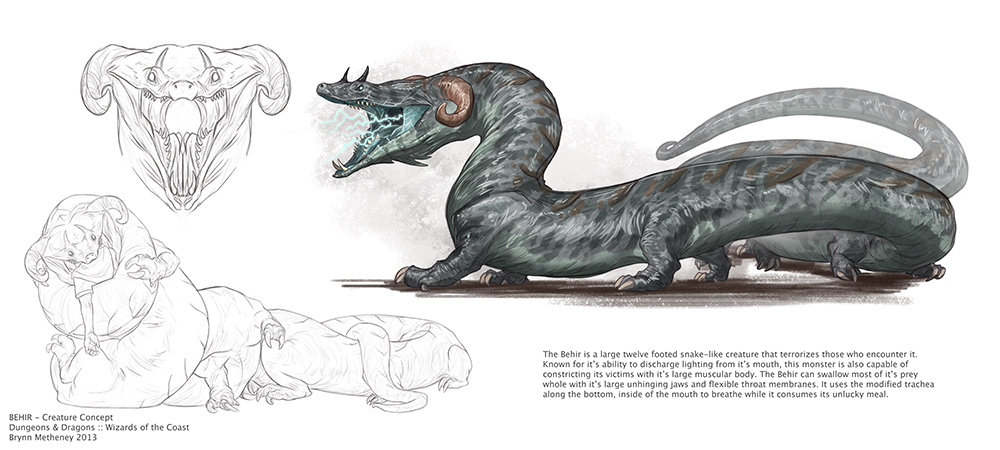

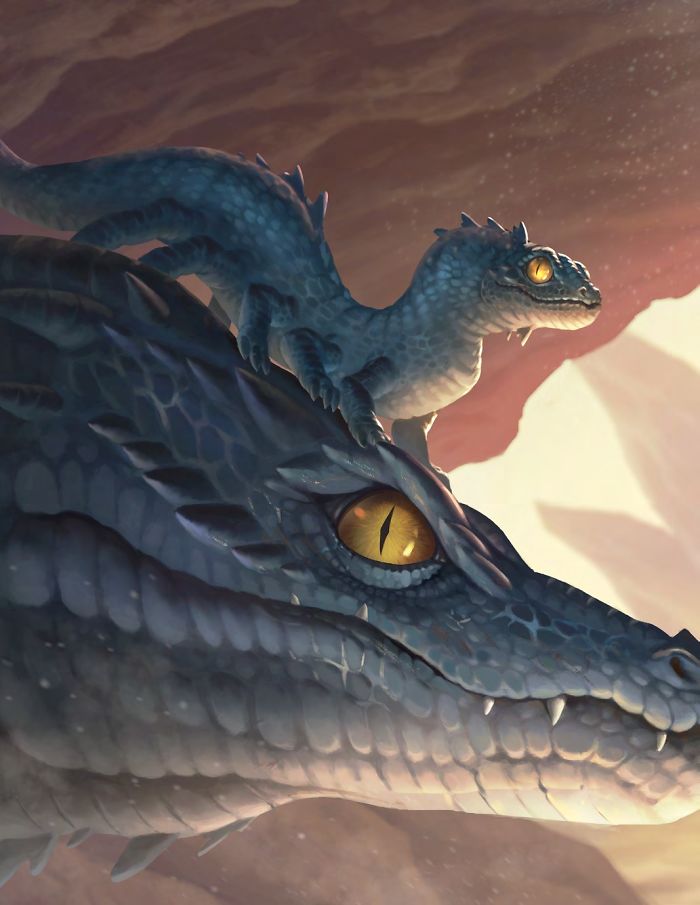
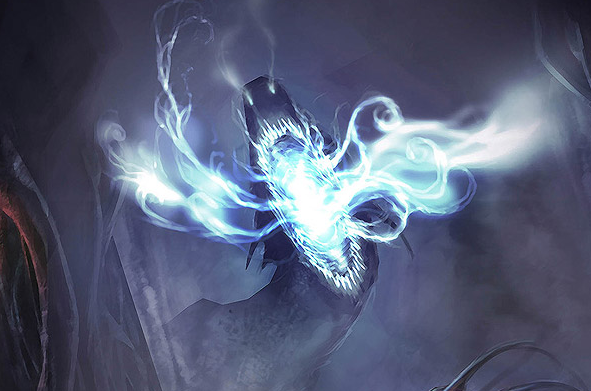
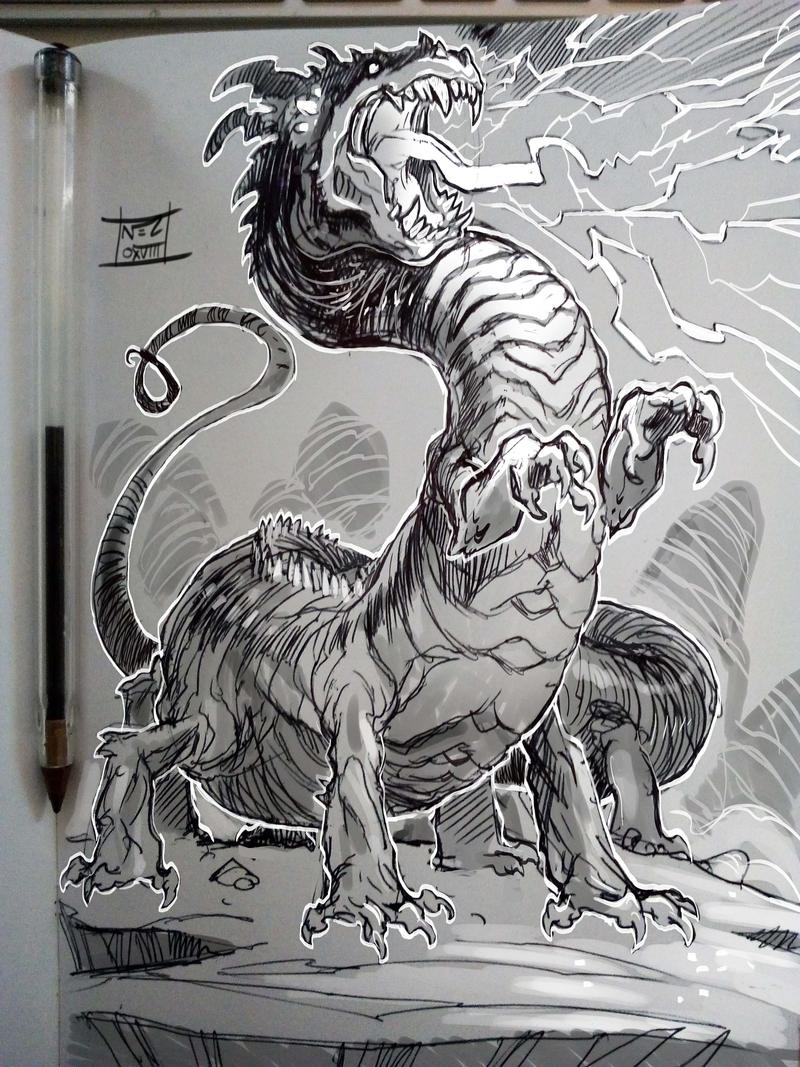
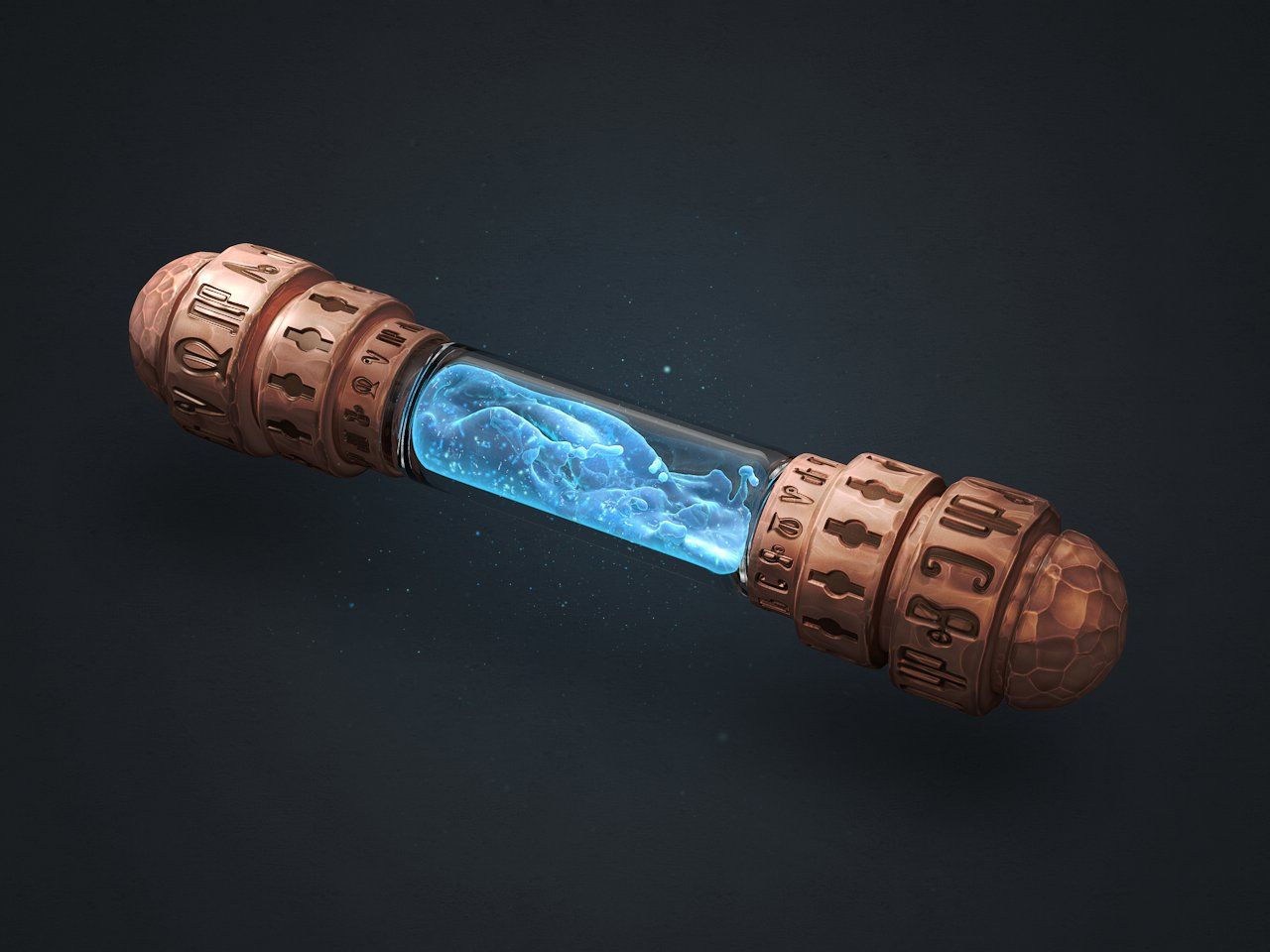
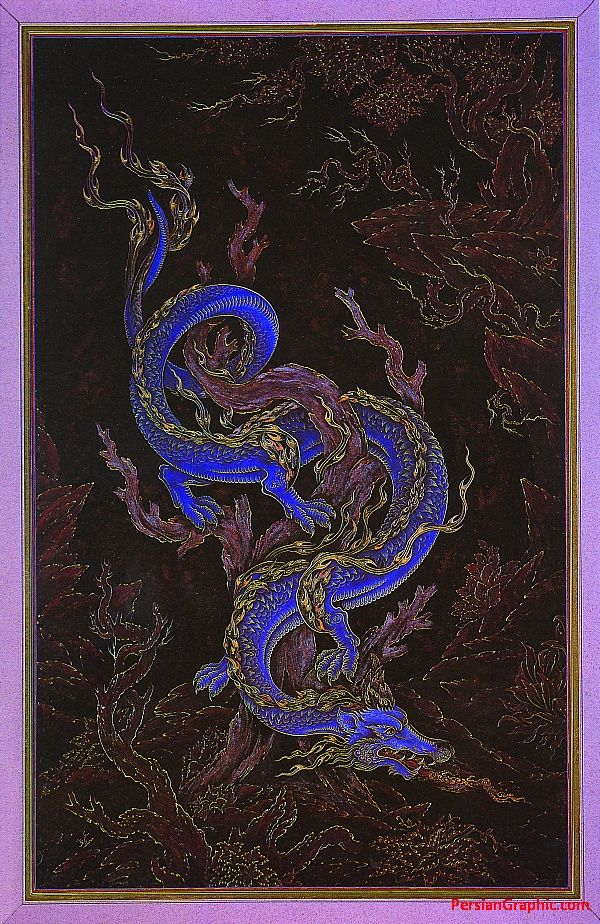
Comments